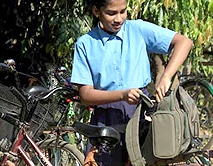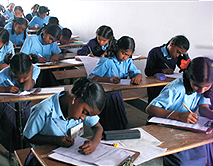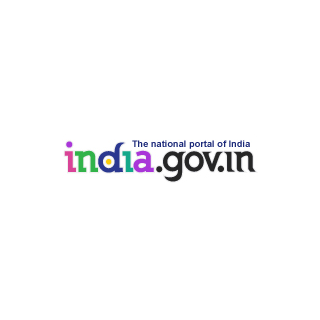
The Rashtriya Madhyamik Shiksha Abhiyan (RMSA) is a flagship scheme of Government of India, to enhance access to secondary education and improve its quality.
Rashtriya Madhyamik Shiksha Abhiyan (RMSA) aims to increase the enrolment rate by providing a secondary school within reasonable distance of every home. It also aims to improve the quality of secondary education by making all secondary schools conform to prescribed norms, removing gender, socio-economic and disability barriers, and providing universal access to secondary level education.
The implementation of the scheme to generate human capital and provide sufficient conditions for accelerating growth and development and equity as also quality of life for everyone in India. The scheme involves multidimensional research, technical consulting, implementation and funding support.

Education provides the surest instrument for attaining sustainable development of a high order in a country. In this regard, primary education acts as the basic enabling factor for participation, freedom and overcoming of basic deprivation; whereas secondary education facilitates economic development and establishment of social justice. Over the years, liberalisation and globalisation have led to rapid changes in scientific and technological world and have prompted the general needs of improved quality of life and reduced poverty. This undoubtedly necessitates the school leavers to acquire higher levels of knowledge and skills than what they are essentially imparted with throughout the eight years of elementary education. Also, a crucial stage in the educational hierarchy, secondary education empowers children to aggrandise nations by preparing them for higher education and also the world of work.
Following the recommendations of New Education Policy of 1986 and Programme of Action, 1992 the Government of India initiated different schemes to support children of secondary and higher secondary schools at different points in time. The IEDSS (formerly IEDC), Girls' Hostel, Vocational Education and ICT@schools schemes were started with the overall objective of providing accessible, and relevant secondary education of good quality in India. In partnership with State Government and Local Self Government, RMSA was the most recent addition to these four existing schemes.
Objectives
- The scheme envisages achieving a gross enrolment ratio of 75% from 52.26% in 2005-06 for classes IX-X within 5 years of its implementation, by providing a secondary school within reasonable distance of any habitation.
- Improve the quality of education imparted at secondary level by making all secondary schools conform to prescribed norms.
- Remove gender, socio-economic and disability barriers.
- Provide universal access to secondary level education
- Enhance and universalize retention by 2020
Physical Facilities
- Additional class rooms
- Laboratories
- Libraries
- Art and crafts room
- Toilet blocks
- Drinking water provisions
- Residential Hostels for Teachers in remote areas.
Quality Interventions
- Appointment of additional teachers to reduce PTR to 30:1
- Focus on Science, Math and English education
- In-service training of teachers
- Science laboratories
- ICT enabled education
- Curriculum reforms; and
- Teaching learning reforms.
Equity Interventions
- Special focus in micro planning
- Preference to Ashram schools for up gradation
- Preference to areas with concentration of SC/ST/Minority for opening of schools
- Special enrolment drive for the weaker section
- More female teachers in schools; and
- Separate toilet blocks for girls.
Rashtriya Madhyamik Shiksha Abhiyan
Rashtriya Madhyamik Shiksha Abhiyan
Rashtriya Madhyamik Shiksha Abhiyan
Rashtriya Madhyamik Shiksha Abhiyan
Rashtriya Madhyamik Shiksha Abhiyan
Rashtriya Madhyamik Shiksha Abhiyan

Ministry of Human Resource Development (MHRD) is the nodal central government ministry to coordinate RMSA with the help of RMSA State Implementation Societies (SIS) in each state. However, there are a lot of support arrangements and institutions available for better implementation of RMSA. A National Resource Group (NRG) provides guidance for bringing about reforms in teaching learning processes, curriculum, teaching learning material, ICT education and mechanisms of monitoring and evaluation. The Technical Support Group (TSG) supported by MHRD, is a constituent of the NRG and has a direct reporting relationship with the ministry. TSG provides technical and operational support and expertise to national and state level teams.
Besides this, various sub-committees like Curriculum Reform Subcommittee, Teacher and Teacher Development Subcommittee, ICT Subcommittee and Planning and Management Subcommittee have been constituted under NRG. These subcommittees comprise members from the TSG and meet thrice a year to apprise themselves of the progress made on mutually set goals and commitments. In addition, NCERT and NUEPA support through dedicated RMSA units. RMSA-TCA has also been set-up for capacity building support with the assistance of DFID. In terms of financial inputs, the central share is released to the implementing agencies directly, whereas the applicable state share is also released to the agencies by the respective State Governments.
Project Monitoring System (PMS)
In a significant step towards leveraging technology to enhance efficiency and manage the implementation of RMSA, a Project Monitoring System (PMS) has been enabled in the website, in which States/UTs may view the Status of all components' (RMSA, ICT, IEDSS, GH & VE) GoI Releases, approved outlays, coverage as per UDISE, status of teachers, school wise list of approvals, school wise gaps etc. under Integrated RMSA. In addition, on line submission of Monthly Progress Reports, physical as well as financial, can also be made by the respective State/UTs in the PMS.
The core objective for implementation of Project Monitoring System is:
- To obviate the need for submitting hard copies, except where it is mandated otherwise.
- To have transparency and accuracy in the System w.r.t Approvals, Releases, Financial Status.
- To streamline the Financial Management system.
- To facilitate Just in Time movement of funds to lower levels of Program Implementation.
- To help in better financial management, more accurate assessment of actual requirement for implementation.

The Information and Communication Technology (ICT) in schools have been subsumed in the Rashtriya Madhyamik Shiksha Abhiyan (RMSA). Now ICT in Schools is a component of the RMSA. The Scheme is a major catalyst to bridge the digital divide amongst students of various socio economic and other geographical barriers. The Scheme provides support to States/UTs to establish computer labs on sustainable basis.
Related Links





